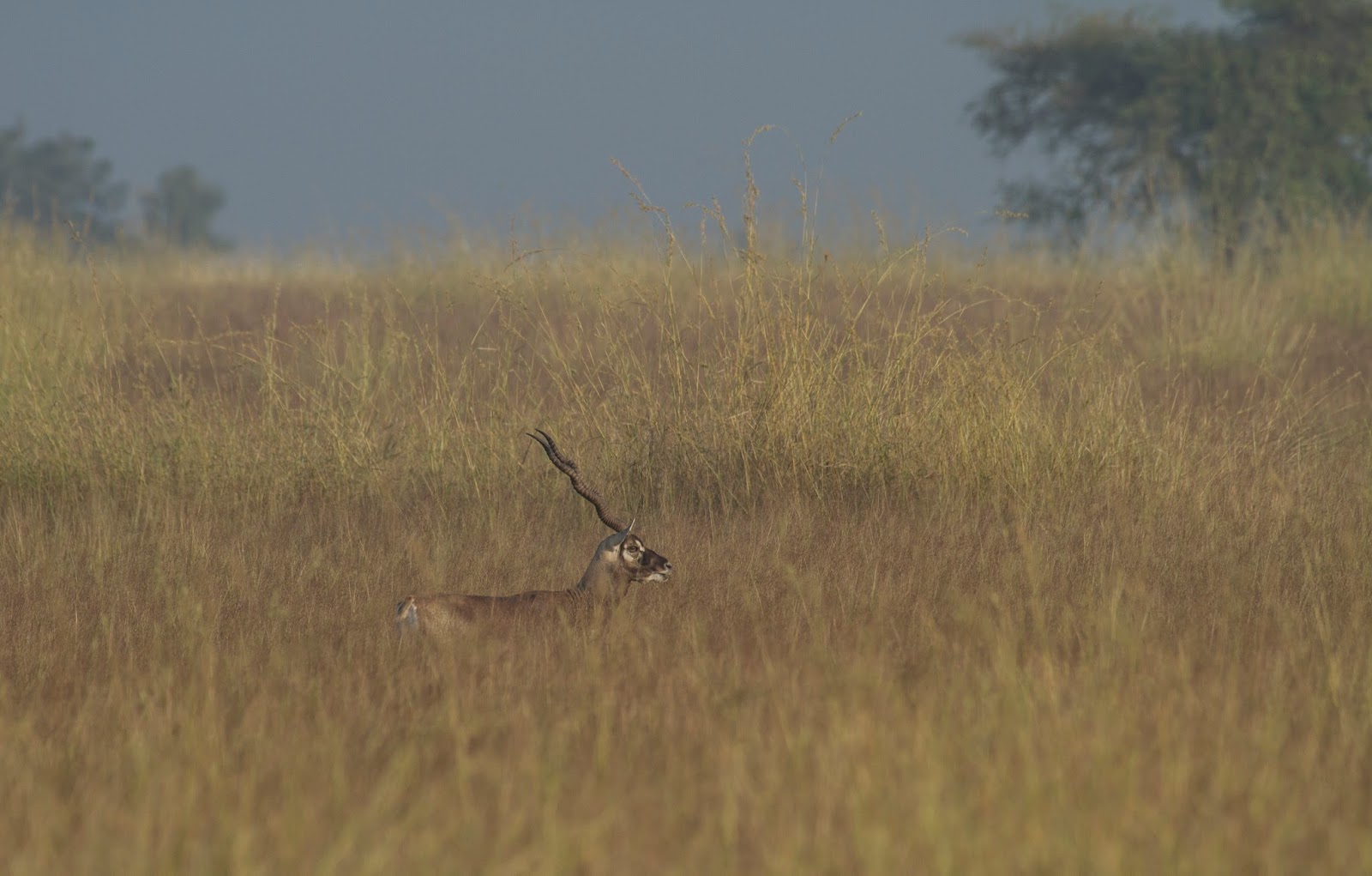Rollapadu Wildlife Sanctuary is located in
kurnool district of Andhra Pradesh. It is located around 45 km from Kurnool
town, it covers an area of over 614 sq. km. Rollapadu is primarily a grassland
ecosystem with mixed forests and thorny bushes. Cotton, tobacco and sunflower
are cultivated in the agricultural lands that border the sanctuary.The
sanctuary was set up in 1988 to protect the endangered Great Indian Bustard and
the Lesser Florican. There are just 200 great Indian bustards in India.The
International Union for Conservation of Nature (IUCN) recently included the
great Indian bustard in its 'red list' of endangered animal species. The Indian
Bustard are believed to have completely disappeared from Haryana, Punjab,
Orissa, Uttar Pradesh and Tamilnadu. There are only 10 Bustard in Rollapadu and
its found to be difficult to site this bird. (Wiki)
We took Kacheguda express which starts from
Chennai Egmore at 5pm (21.11.2014) and we reached Kurnool at 4.15 am. We refreshed ourself in a local lodge and
around 5 am we started our journey to Rollapadu to sight the great Indian
Bustard and blackbucks. We hired a Jeep to Rollapadu, which was very useful as it would be
difficult for other vehicles to go through this grassland. We reached Rollapadu
Sanctuary around 6 am.
Rollapadu wildlife sanctuary is one of the
finest grasslands present in India. Picture tall brown grass welcomed us and on the way we sighted plenty of birds. If you observe closely into the grass land you can see leaping blackbucks.
Trying to get close to Blackbucks.(Dhanjayan and Yegnaram in action)
Blackbuck (Antilope cervicapra) is also called as murukumaan in Tamil. The Blackbuck is one of the five species of Antelopes found in India.
These graceful animals were seen in large numbers at the beginning of
the century. It is an ungulate species of antelope native to the Indian subcontinent that has been classified as near threatened by IUCN since 2003, as its range has decreased sharply during the 20th century (Wiki). Blackbucks generally live on open plains and open woodlands in herds of 5 to 50 animals with one dominant male. They are very fast. Speeds of more than 80 km/h (50 mph) have been recorded.
Blackbuck are antelopes that congregate in open plains and form territories. They defend these territories against male intrusion. These animals are territorial most of the year in Rollapadu. Females form herds of their own with juveniles of both sexes. Blackbuck does visit the males in the territory only temporarily for short periods of a few hours to maybe a day or two. The male is alone a considerable part of the time in his territory. Female blackbuck herds move about and feed outside the territories. The females may not stop at the first territory, but move sequentially
through one territory to another, till she grazes at the territory of
her choice. Source: Menon, R. K. G. (2009)
Territorial Male
The maduvu or maan koombu or maru is a weapon typically consists of two blackbuck horns. The maru originated among the Dravidians of south India and was favoured by the Bhil people.
Female Blackbuck
Female herd running when we come near to it...
Jumping blackbuck
Blackbuck, when it is at the height of its long leap, is an amazing wildlife experience to photograph. The jumping Blackbuck images looks great but usually these images are captured by provoking and chasing the animals to get the photograph. It would be natural if the chase is done by some predators. I feel this behaviour should not be encouraged by wildlife photographers.

Male chasing another blackbuck male which has entered its territory.
Rollapadu is the birds paradise. some the birds clicked are listed below
Large grey babbler (Turdoides malcolmi)
Laughing dove (Spilopelia senegalensis)
Greater coucal (Centropus sinensis)
Bulbul
Rose-ringed parakeet (Psittacula krameri)
Ashy-crowned sparrow-lark (Eremopterix
griseus)
Green bee-eater (Merops orientalis) catch an insect in mid-air, come back to
their perch.
Common Hopoee
Indian roller (Coracias benghalensis)
Black drongo (Dicrurus macrocercus)
Southern grey shrike (Lanius meridionalis)
Indian bush lark
Red-wattled lapwing (Vanellus indicus)
Montagu's harrier (Circus pygargus)
Great Indian Bustard flying in the background (look like)
We spend a day in Rollapadu Sanctuary and had a great time to seeing this unique ecosystem. Like to thank our special guide Mr.Gafoor and Jeep driver. We missed to sight the great Indian bustard and will love to visit again to focus on Bustard, Lesser Florican, Buzzard, Kites, Owls, Eagles Night-jars etc. We enjoyed authentic Andhra meals in midtur which is around 6 km from Rollapadu. Don't miss the mini tea (50 ml) near Rollapadu bus stand. It is an important place to visit in South India for wildlife photographers. We took the 8.15pm train to Chennai from Kurnool. We also tried the delicious Pulla Reddy sweets of Kurnool and viewed the famous Konda Reddy Fort.








































6 comments:
Our own IIT Madras also has a few kinds of DEERS as we usually call them. Your Madras Christian college also has varieties of birds I suppose.
Yes good number of birds in IIT and MCC...will click and upload it in this blog soon
Like every traveler, I also enjoy taking pictures but mine are not as good as yours. I really admire your photography skills. These pictures are amazing. You have captured them so beautifully. My favorite one would be “Dhanjayan and Yegnaram in action”!
I had been thinking and probably thinking way too much, on whether I should plan a visit there. Still I'm not entirely convinced that I should go there specially so when the bustard is so difficult to spot in one or 2 outings and almost impossible to click.
Anyway, thanks for the post and info.
Nice clicks.........
Do u have a contact number for the guide........Mr. Gaffor?
If u do, appreciate it
Hi, do assist us regarding the formalities for getting permission to visit Rollapadu and details about the guide and travels would be of more helpful. (amurali_krishnan@hotmail.com) thank you in advance.
Post a Comment